Founded in 1987, CheckSum has been delivering reliable, cost-effective, and flexible in-circuit test and on-board, in-system programming solutions to OEMs and contract manufacturers (CM). With an installed base of over 3,000 test systems at more than 200 manufacturing sites in over 40 countries, CheckSum’s customers range from automotive electronics manufacturers to global EMS / CM providers.
CheckSum’s practical production test and on-board, in circuit, part programming solutions help its customers reduce total test and manufacturing costs and increase profit margins.
Read these customer case histories and newsletters to see how CheckSum delivers solutions that meet the demanding technical requirements while reducing total cost:

Tier 1 Contract Manufacturer Cuts Programming Cost by 66%
On-Board Part Programming with Pay-Per-Use
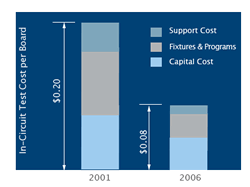
How One Manufacturer Slashed
In-Circuit Test Cost by 60%
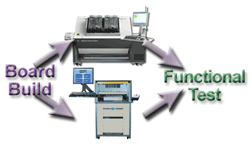
CheckSum’s Analyst Works
Side-By-Side with ’Big Iron’ In Circuit
Testers at a Fraction of the Cost
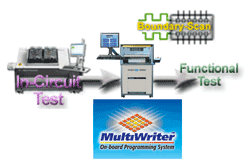
An OEM finds the Analyst is the
Ideal Platform for Boundary Scan
Test and High Throughput In Circuit
Part Progamming
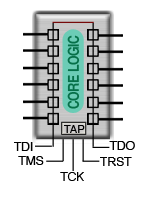
Contract Manufacturer (CM) Implements
Boundary Scan Test on a New Board with
CheckSum’s Analyst In Circuit Test System
Fault Coverage Improves 30%
Managing Your Tester Portfolio and
Achieving a Low Cost Board Test Strategy
Many test engineers seek to „standardize” on a single brand or model in circuit tester. Intuitively, this makes sense: only one vendor to deal with, common fixturing, a single programming environment, simplified support. In order to deal with any board of any complexity, it seems to also make sense to standardize on traditional high-end in circuit tester that has all the reserve horsepower–high accuracy analog, sophisticated digital backdrive, functional test facilities, etc.–that the test engineer might ever need.
ICT Platform „Standardization” Means Higher Cost of Test
But traditional „big iron” ICT always drives up overall test cost–even when it’s the „standard” that’s supposed to reduce overall test cost. The theoretical savings of a “standard” rarely offsets the high fixturing, programming and support costs that traditional ICTs entail. A high capability tester is absolutely right for a high complexity board. But putting a simpler board on a „big iron” ICT is analogous to planting a rosebush with a backhoe: The job gets done, but it’s a lot more complicated and expensive compared to putting the less complex board on a less complex tester that has lower application and support costs.
Tester Portfolio Management is Straightforward
Just as a portfolio manager maximizes investor return by using a variety of investment vehicles, the „tester portfolio manager” will distribute test jobs between the „big iron” ICT and the Low Cost ICT based on criteria such as board complexity and production volume. This way, lower cost testers, fixtures and programs test boards that don’t require expensive capabilities like digital backdrive. Complex boards, such as those with specialized low-voltage chips are tested on machines with the required tester resources.
Tester Portfolio Management Saves Money
Tester Portfolio Management reduces total test cost by avoiding unnecessary tester overhead for test jobs that don’t require expensive „big iron” test capabilities–especially digital vector test (aka 'backdrive’). Because Low Cost ICT does away with the inherent complexity of digital test not only is the tester itself simpler and less expensive, but fixtures and programs, too. One user who implemented the same board on both types of testers experienced a greater than 75% cost savings in applications cost (fixture + test program) on the Low Cost ICT. Check out a similar case for yourself.
Consider Test Cost Up Front. Not After It’s Too Late.
When implementing new test jobs seek the lowest cost test solution by evaluating the total test cost ahead of time– even if it means investing in a „non-standard” Low Cost ICT . Today, „big iron” and Low Cost ICT coexist on an increasing number of test floors delivering much lower total testing cost than a single high-end „standard.” Even though building a tester portfolio instead of a single standard seems counterintuitive. That’s what a major automotive electronics manufacturer thought until they reduced test cost by more than 60% without any increased „escapes” to functional test.
Improve manufacturing margins by reducing test cost
Test is necessary but wasteful because it adds no value to the product. In today’s world of tight manufacturing margins circuit board test is an ideal cost reduction target. Yet, many OEMs and contract manufacturers (CMs) continue to generate unnecessary cost—and reduce their margins—by continuing to put every test job on their expensive ‘big iron’ in circuit testers with their high fixturing, programming and support costs.
CheckSum estimates that by sticking with traditional ‘big iron’ ICTs instead of investing in Low Cost ICT, OEMs and CMs unnecessarily spend more than $250 million per year in additional test cost. In a world where every margin dollar makes a difference, reducing that unnecessary cost is an ideal way to improve the manufacturing bottom line.
The example at right illustrates how a contract manufacturer with 5% gross margins can add 40 basis points to its gross margin—an 8% improvement—by reducing circuit board test costs by just 10%. One Tier 1 manufacturer found that it could reduce in circuit test cost by 60%. Even if ICT cost represents just half of total board test cost, that’s a 30% cost reduction.
CMs who have recognized and seized this cost reduction opportunity are enjoying both increased operating margins and competitive advantage. OEMs who recognize that test costs can be reduced are well positioned to negotiate lower overall prices from their CM.
3 steps to reduce board test cost
Myślenie poza jedną platformą w strategii testu.
Duże stałe testery obwodów sprzedawane są od lat jako platforma „robiąca wszystko”: analogowe w obwodzie; cyfrowy test wektorowy (backdrive), test wektorowy, programowanie ISP, skanowanie granic, test funkcjonalny oparty na oprzyrządowaniu itp.
Ujednolicenie wszystkich tych zadań może uprościć i ujednolicić zadanie grupy testowej, bez względu na to, jakie niespodziewane nowe technologie mogą wysłać projektanci produktu. Nie ma dodatkowego wyposażenia uzasadniającego zarządzanie i kupowanie. Personel jest już przeszkolony w zakresie korzystania z systemu. Wielki dostawca testerów stałych mówi: „Po prostu dodaj opcjonalny sprzęt i oprogramowanie, a będziesz gotowy”.

Ale rzeczywistość jest zawsze bardziej skomplikowana.
Strategia testu dwustopniowego
Na początku wydaje się to sprzeczne z intuicją, ale wdrożenie nowych testów na nowej, taniej platformie może drastycznie uprościć ogólne zadanie, przyspieszyć przepustowość i kosztować znacznie mniej niż próba zintegrowania wszystkiego w dużymstałym testerze. W jaki sposób?
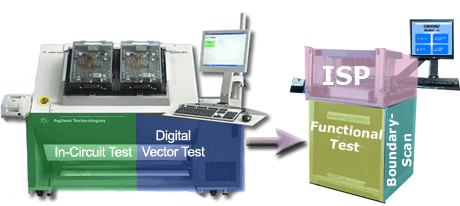
New Circuit Board Technology Requires New Strategic Thinking
Circuit board technology evolves rapidly: more highly integrated devices, increasing package pin counts, denser placement of smaller components and thinner circuit traces. For boards ranging from simple to complex, the test and inspection process remains as critical as ever. Bad parts still find their way onto boards. Assembly and soldering defects still occur. In-circuit test (ICT) is still the most cost effective means to identify component faults and manufacturing process defects. And as long as there are circuit boards, ICT will continue to be the key to effective manufacturing process test.
But evolving technology requires a complete rethinking of in-circuit test strategy—and about the in-circuit tester itself.
Traditional ICT capabilities are increasingly expensive—and unnecessary
The Fault Spectrum Shifthas basically negated the cost effectiveness of traditional ICT testers such as the Agilent 3070-series and Teradyne TestStation. Capabilities found on these testers such as high-accuracy analog and digital vector test are increasingly superfluous because they are designed to test for faults that rarely—if ever—occur on today’s boards. In fact, traditional digital vector test is ineffective on today’s complex, highly integrated devices. And newer assembly defect classes such as cold solder joints and skewed components are simply invisible to in-circuit testers and must be diagnosed by other means such as automated imaging (AOI, AXI).
Evolving technologies aren’t the only reason you should reexamine your ICT strategy and equipment. Today’s smaller test departments and constrained budgets demand lower ICT costs. In a fixed budget environment every dollar you spend unnecessarily on ICT means a dollar that you can’t invest in new inspection technologies like AOI and AXI.
The Low Cost ICT strategy
Seeking a lower-cost ICT strategy demands that you examine not only the purchase price of the tester, but also ongoing operating and applications cost, such as fixturing, programming, and support. Keep in mind that no matter how low the purchase price, “big iron” ICT still has high overhead costs from complex test fixtures and lengthy test programming processes—even when built-in capabilities like vector testing are not even used.
The good news about new board and parts technologies and the resulting Fault Spectrum Shift is that much lower cost ICT systems will do the job as effectively as old, expensive ones. That’s where the CheckSum Analyst Low Cost In-Circuit Testers come in. Check them out and see how CheckSum can reduce testing cost and help increase manufacturing margins.
Circuit Boards Have Changed.
So Has The Board Test Fault Spectrum.
Over the past several years printed circuit board assembly yields have increased as component and assembly process defect rates have decreased as shown in the figure on the right. In addition, the distribution of fault types typically found on boards during the manufacturing and assembly process has shifted over the past several years as illustrated in the fault spectrum pie diagrams to the right.
Why Does the Shifted Fault Spectrum Matter? Because the Fault Coverage of Traditional In Circuit Testers Is Declining.
The Shifted Fault Spectrum also means that the faults that traditional ICT is adept at finding occur much less frequently—reducing overall tester effectiveness—but not cost.
As a Result
Test engineers have eliminated almost all of the tests traditional ICT was designed to do well—resulting in simple in circuit programs that leave all that „big iron” ICT capability either under-used or unused. This mismatch between today’s fault spectrum and yesterday’s traditional ICT means high overhead costs for unused tester resources in the form of more complicated fixtures and programs and the higher support costs inherent in complex testers.
New Technologies Will Augment In Circuit Test (ICT)
While ICT remains the most economical means to identify manufacturing and component defects, new technologies such as Automated X-Ray Inspection (AXI) and Automated Optical Inspection (AOI) are being integrated into assembly lines to deal with the new defect classes that ICT can no longer—or simply never could—identify.
What Does the Shifted Fault Spectrum Mean For ICT?
If test engineers continue to use traditional „big iron” ICT for every test job, OEMs and contract manufacturers will keep generating unnecessary test costs. For North America alone, CheckSum estimates that more than $250 million annually is spent unnecessarily on testers, tester support, test programs and fixtures by using „big iron” where Low Cost ICT will do the job. Employing Tester Portfolio Management will reduce total ICT cost while maintaining superior fault coverage–and free up budgets to fund the new AOI and AXI technologies that today’s new board technologies also require.